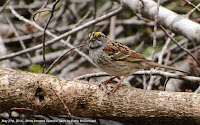WHITE-THROATED SPARROW
WHITE-THROATED SPARROW (Zonotrichia albicollis) – (See images below)
DESCRIPTION:The White-throated Sparrow, in addition to its white throat, has black and white stripes on the head, and the two outer white stripes start with a yellow spot. The back is brown and the underside grey. The wings are mottled brown with thin white edges. The tail is relatively long. The conical bill is grey and the legs are pinkish grey. Sexes are similar, and juveniles lack the yellow spot on the face. The length of this bird approximates 17 cm (7 inches).
VOICE: https://www.xeno-canto.org/species/Zonotrichia-albicollis – The main song of this species is a clear series of ascending or descending notes. It responds well to ‘pishing’.
NAME: The English name ‘Sparrow’ derives from Anglo-Saxon ‘Spearwa’, which means ‘flutterer’, and it has been applied to many small birds (Choate). The Latin genus name ‘Zonotrichia’ is from Greek and means ‘band’ and ‘hair’. As for the Latin species name ‘albicollis’, it means ‘white neck’.
HABITAT: Woodlands, either mixed or coniferous.
DIET: White-throated sparrows forage for food – seeds, insects – on the ground.
NESTING: The nest is built by the female, usually on the ground in a well-concealed area. An average of five light blue-green eggs are laid, which are incubated by the female. Both parents feed the chicks.
DISTRIBUTION: The breeding range of this New World sparrow encompasses most of the Canadian forest east of the Rockies, around the Great Lakes and the northeast USA. It is a year-round resident in the middle portion of the USA east of the Rockies, and migrates in the southeast USA for the most part.
Distribution map: https://en.wikipedia.org/wiki/White-throated_sparrow#/media/File:Zonotrichiaalbicollis_habitat.PNG
ON PEI: The white-throated sparrow breeds on Prince Edward Island, and is very common for most of the year except in the winter.
CONSERVATION: Overall the population of this widespread sparrow has slightly declined in the last few decades.
NOTES: The white-throated sparrow forages for seeds on the ground along Song Sparrows and Dark-eyed Juncos.
SIMILAR SPECIES: White-crowned Sparrow, Song Sparrow
REFERENCES: https://www.mba-aom.ca/jsp/toc.jsp (Maritimes Breeding Bird Atlas)
https://animaldiversity.org/accounts/Zonotrichia_albicollis/
American Bird Conservancy (white-throated sparrow)
https://www.audubon.org/field-guide/bird/white-throated-sparrow
https://www.borealbirds.org/bird/white-throated-sparrow
https://en.wikipedia.org/wiki/White-throated_sparrow
https://nature.mdc.mo.gov/discover-nature/field-guide/white-throated-sparrow (Missouri Department of Conservation)
This video below shows a white-throated sparrow feeding on black sunflower seeds on the ground.
DESCRIPTION:The White-throated Sparrow, in addition to its white throat, has black and white stripes on the head, and the two outer white stripes start with a yellow spot. The back is brown and the underside grey. The wings are mottled brown with thin white edges. The tail is relatively long. The conical bill is grey and the legs are pinkish grey. Sexes are similar, and juveniles lack the yellow spot on the face. The length of this bird approximates 17 cm (7 inches).
VOICE: https://www.xeno-canto.org/species/Zonotrichia-albicollis – The main song of this species is a clear series of ascending or descending notes. It responds well to ‘pishing’.
NAME: The English name ‘Sparrow’ derives from Anglo-Saxon ‘Spearwa’, which means ‘flutterer’, and it has been applied to many small birds (Choate). The Latin genus name ‘Zonotrichia’ is from Greek and means ‘band’ and ‘hair’. As for the Latin species name ‘albicollis’, it means ‘white neck’.
HABITAT: Woodlands, either mixed or coniferous.
DIET: White-throated sparrows forage for food – seeds, insects – on the ground.
NESTING: The nest is built by the female, usually on the ground in a well-concealed area. An average of five light blue-green eggs are laid, which are incubated by the female. Both parents feed the chicks.
DISTRIBUTION: The breeding range of this New World sparrow encompasses most of the Canadian forest east of the Rockies, around the Great Lakes and the northeast USA. It is a year-round resident in the middle portion of the USA east of the Rockies, and migrates in the southeast USA for the most part.
Distribution map: https://en.wikipedia.org/wiki/White-throated_sparrow#/media/File:Zonotrichiaalbicollis_habitat.PNG
ON PEI: The white-throated sparrow breeds on Prince Edward Island, and is very common for most of the year except in the winter.
CONSERVATION: Overall the population of this widespread sparrow has slightly declined in the last few decades.
NOTES: The white-throated sparrow forages for seeds on the ground along Song Sparrows and Dark-eyed Juncos.
SIMILAR SPECIES: White-crowned Sparrow, Song Sparrow
REFERENCES: https://www.mba-aom.ca/jsp/toc.jsp (Maritimes Breeding Bird Atlas)
https://animaldiversity.org/accounts/Zonotrichia_albicollis/
American Bird Conservancy (white-throated sparrow)
https://www.audubon.org/field-guide/bird/white-throated-sparrow
https://www.borealbirds.org/bird/white-throated-sparrow
https://en.wikipedia.org/wiki/White-throated_sparrow
https://nature.mdc.mo.gov/discover-nature/field-guide/white-throated-sparrow (Missouri Department of Conservation)
 |
| White-throated sparrow, Kathy McCormack |
 |
| White-throated sparrow by Kathy McCormack |
 |
| White-throated sparrow, by John Read, PEI |